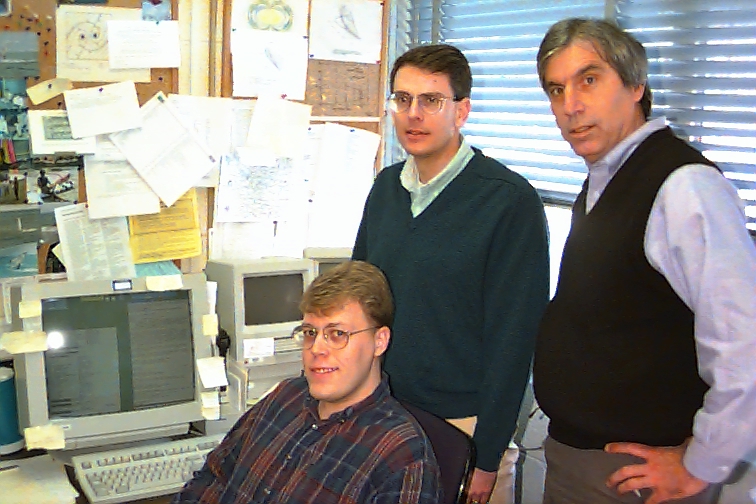
1. Code Name: JSOLVER
2. Category: IIa. Plasma Equilibrium: 2D Fixed Boundary
3. Responsible Physicist: S. Jardin(right)
4. Others involved in code development: D. Monticello, J.Menard(left), C.Kessel(center)
5. One line description: Fixed boundary MHD equilibrium code with prescribed p and J profiles.
6. Computer systems which code runs on: NERSC Cray computers.
7. Typical running time (if applicable): 1-30 minutes
8. Approximate number of code lines: 5000
9. Does this code read data files from another code? Yes, it can read an EQDISK file from TSC.
10. Does this code produce data files that can be read by another code? If so, explain. Yes, it can write an EQDISK file to be read by the MAPPER code.
11. 1-2 paragraph description of code: This code uses the iterative metric method (see ref. in. 13) to simultaneously solve for plasma equilibrium and the magnetic flux coordinates. During each iteration, it solves an ordinary differential equation for the toroidal field function g so that the surface averaged parallel current density take on a prescribed form. It has an automatic zone doubling feature to allow efficient generation of high accuracy equilibrium.
12. Similar codes to this code, and distinguishing differences: Similar to QSOLVER, but keeps surface averaged current density fixed rather than the q-profile.
13. Journal References describing code (up to 3): The original basis for this code is described in the 2 papers: (1) DeLucia, J., Jardin, S. C., Todd, A. M. M., J. Comput. Phys. 37 2 (1980). (2) Chance, M., Jardin, S. C., Stix, T., Phys. Rev. Lett. 51 1963 (1983).
14. New code capabilities planned for next 1-2 years: Speed convergence using multigrid techniques.
15. Code users: C. Kessel, N. Pomphrey, J. Manickam, D. Monticello, M. Chance (PPPL), J.Menard (PPPL), T.K.Mau (UCSD), J. Ramos (MIT), T. Kaiser (LLNL), C. Bathke (LANL), S. Sabbagh (Columbia)
16. Present and recent applications of code: Second stability studies for ARIES, BPX stability studies, reversed shear configuration stability studies, Low-A stability and bootstrap studies
17. Status of code input/output documentation. Check one: ( ) does not exist ( ) incomplete (X) exists
18 .Year Code was first used and present frequency of use: First used in 1983. Now used very frequently (daily) by several people.
19. Estimate of Man-Years invested in developing code: 4
20. Catagories of usage of Code (Check all that apply): (x) application code to do analysis and prediction of experiments (x) numerical testbed of theoretical ideas (x) physics module to be used in integrated moddelling (x) code for machine design
21. Language code is writen in: Fortran
22. Results of intercomparisons with other codes and results of validation against experiments. This code has recently been validated against Drozdov's POLAR2D code, and found to converge to the same solution;